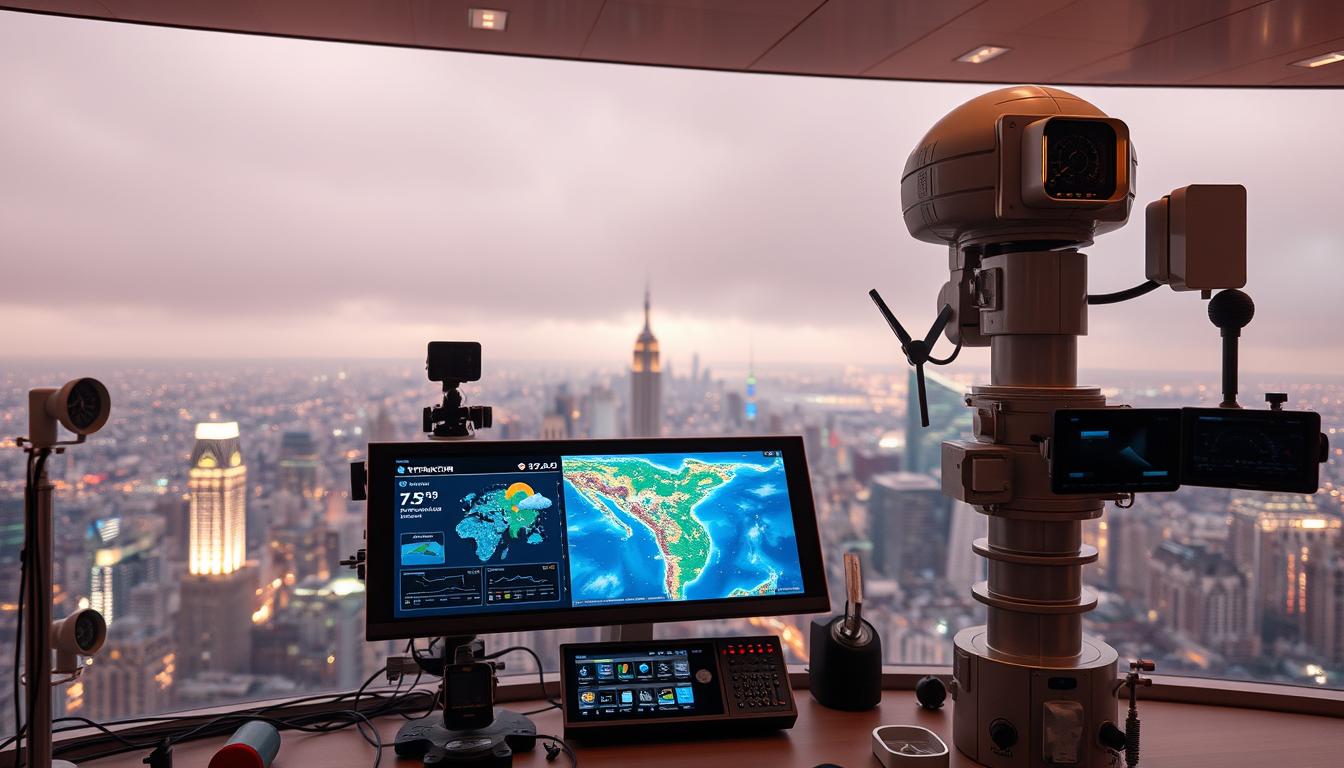Remember when checking the weather was as simple as looking out your window? Those days are quickly disappearing. Today, we need more accurate weather info due to climate changes. Modern weather monitoring devices give us just that.
The change is amazing. What began with simple mercury thermometers and analog barometers has evolved into advanced digital systems. These tools track many conditions at once. They provide real-time data and accurate forecasts right in our hands.
For homeowners, these devices help avoid damage from storms. Farmers use them to protect crops and plan planting. Outdoor lovers use portable stations to stay safe, and hobbyists track weather patterns.
As weather becomes more unpredictable in America, having good monitoring tools is key. Knowing what you need and can afford is the first step to being ready for the weather. Let’s dive into the world of meteorological technology together.
The Growing Importance of Personal Weather Monitoring
Extreme weather events are getting worse in the United States. Personal weather monitoring devices are now key for making daily decisions. We can no longer rely on old weather patterns. Today, we need to track the weather in our own neighborhoods more closely.
Climate Change and Weather Unpredictability
Climate change is real and affecting us every day. Weather patterns are changing in ways that surprise us.
How Extreme Weather Events Are Becoming More Common
Extreme weather is happening more often and getting worse. Scientists say this will keep happening. So, old ways of predicting the weather won’t work as well anymore.
Climate data loggers are now crucial for tracking local weather. They record things like temperature and humidity. This helps us see how our area is changing with the climate.
Weather can change a lot in just a few miles. What your neighbor gets might not reach you. Tools today can show these small changes that big weather forecasts miss.
This local data is super useful during bad weather. Knowing exactly when a storm will hit your place can save you time.
Benefits of Having Your Own Weather Data
Having your own weather data is powerful. It helps you make better choices every day and for the future.
Planning Daily Activities with Confidence
With exact data about your area, you can plan better. Want to have a picnic? Your weather station will give you a better idea than a general forecast.
Long-term Climate Tracking for Your Location
Keeping your own weather records is also valuable. Over time, they help you spot patterns unique to your place. This info is great for taking care of your home, saving energy, and even managing allergies.
Types of Weather Monitoring Devices for Different Users
Choosing the right weather monitoring equipment depends on your needs. The market has everything from simple rain gauges to advanced tools that predict storms. Your choice should match your needs, comfort with technology, and budget.
Consumer-Grade vs. Professional Equipment
There’s a big difference between consumer and professional weather devices. Consumer gear is for home users, gardeners, and hobbyists. Professional tools are for meteorologists, researchers, and businesses.
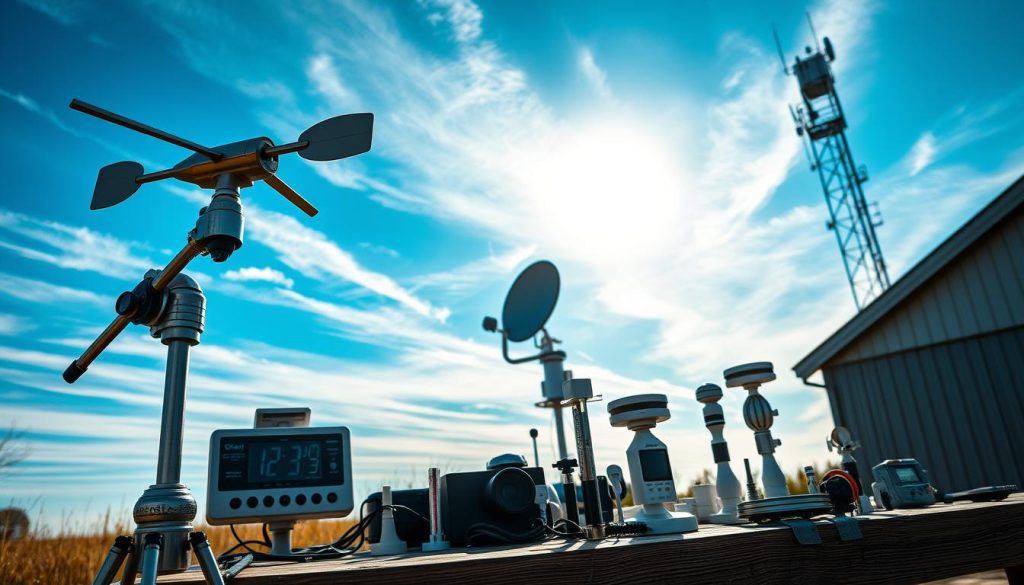
Consumer weather stations cost between $30 and $300. They’re great for tracking weather and hobbies.
Professional tools start at $500 and can go over $10,000. They offer better accuracy and durability for serious use.
Think about how you’ll use the data. Consumer devices are perfect for gardening or fun. But for science or business, you need professional tools, even if they cost more.
Accuracy and Reliability Differences
Consumer devices are accurate within ±1-2°F for temperature and ±5% for humidity. This is fine for home use.
Professional tools are much more precise. They can be accurate to ±0.5°F for temperature and ±2% for humidity. They work well in extreme conditions too.
Wired vs. Wireless Systems
Wireless weather stations are easy to set up and flexible. You can place sensors where they work best without cables.
Wired systems need more setup but are more reliable. They’re good for areas with power outages because they often have backup power.
Internet-Connected vs. Standalone Units
Internet-connected devices send data to the cloud. You can check weather on your phone. They also help with local forecasts.
But, they might not work during severe weather when the internet is down.
Standalone units store data locally. They don’t need the internet. They’re reliable during bad weather when the internet fails.
Essential Components of Modern Weather Stations
The accuracy of a weather station depends on its core components. Whether you’re a casual fan or a serious meteorologist, knowing these parts is key. It helps you choose the right system for your needs.
Temperature and Humidity Sensors
Temperature sensors are crucial for any weather station. Modern units use thermistors or digital sensors for accurate readings, usually within 0.5°F. These sensors need protection from sunlight and good air flow to avoid errors.
Humidity sensors measure air moisture. Capacitive sensors are common, offering accuracy within 3-5% relative humidity. They need regular checks to stay precise, more so in places with big humidity changes.
Barometric Pressure Monitors
Barometric pressure sensors track changes in air pressure. A quick drop can signal a storm, while rising pressure means clearer skies.
Today’s stations use electronic transducers for precise pressure detection, down to 0.01 inHg. This lets you spot weather changes hours early.
Wind Speed and Direction Gauges
Anemometers measure wind speed, with cup anemometers being common. They have cups that spin with the wind.
Wind vanes show direction by pointing into the wind. For best results, mount them 33 feet up and away from buildings or trees.
Rainfall Collection and Measurement
Rain gauges collect rainfall, with tipping bucket designs popular in home stations. They measure rainfall in 0.01 inch increments.
Weighing gauges are more precise but cost more. Optical sensors use infrared to detect rain. Heated gauges in cold areas prevent snow and ice from skewing readings.
Home Weather Stations: The Perfect Starting Point
Starting your journey into personal weather monitoring is easy with a good home weather station. These devices offer professional-grade tracking without costing too much. They let you collect data about your area, perfect for gardening, weather watching, or just curiosity.
Entry-Level Models Under $100
Weather stations on a budget are surprisingly capable. They give you the basics and teach you about tracking the weather.
AcuRite 5-in-1 Weather Station
The AcuRite 5-in-1 is a great starting point for weather fans. It has five sensors in one: temperature, humidity, rainfall, wind speed, and direction. Its color display makes reading data easy, and it transmits wirelessly up to 330 feet.
It’s not as precise as pro gear, but it’s good enough for home use. People like its easy setup and simple interface.
Ambient Weather WS-2000
The Ambient Weather WS-2000 is a great value with smartphone connectivity and expandable sensors. It starts simple and lets you add more sensors as you learn more. The full-color console shows weather info at a glance, and the app lets you check conditions from your phone.
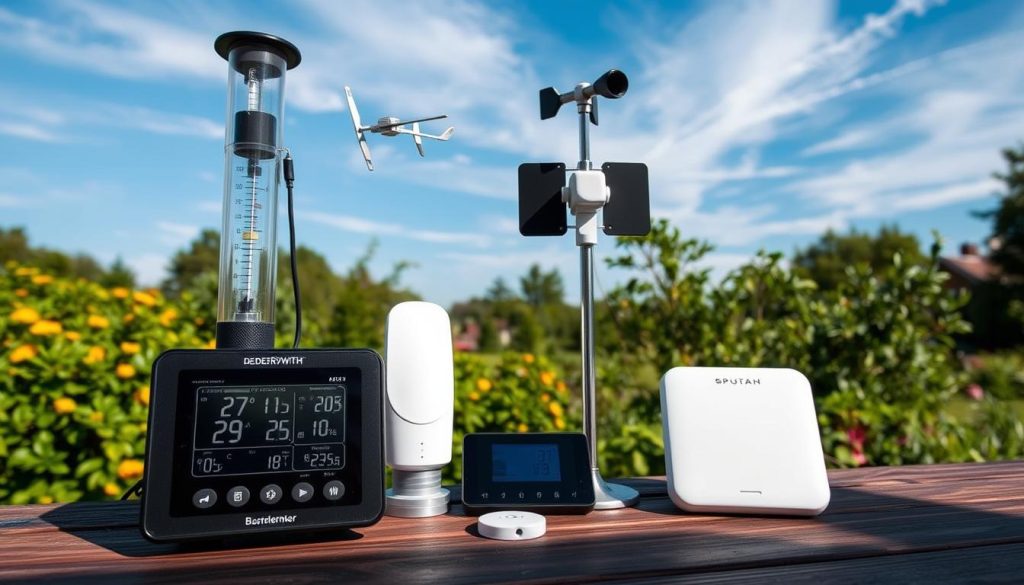
Mid-Range Options ($100-$300)
Mid-range weather stations offer better accuracy, durability, and data collection.
Davis Instruments Vantage Vue
The Davis Vantage Vue is known for its reliability in tough weather. It’s built to last and gives accurate readings. The radiation shield stops false temperature readings from sunlight, a problem with cheaper models.
Weather fans love its long range of up to 1,000 feet and fast updates every 2.5 seconds.
WeatherFlow Tempest Weather System
The Tempest is a new kind of weather monitor with a haptic rain sensor and solar power. It measures rainfall with sound, unlike traditional rain gauges. Its design combines all sensors in one, making it easy to use.
Installation and Placement Best Practices
Installing your weather station right is key to accurate readings. Mount temperature sensors 5 feet up and away from heat sources. Wind sensors should be 10 feet above any nearby objects.
Use a compass to align wind direction sensors with true north. Rain gauges need to be level to avoid errors. Even if your station isn’t perfect, it still gives useful data. Just be aware of how the environment might affect your readings.
| Weather Station Model | Price Range | Key Features | Best For | Accuracy Rating |
|---|---|---|---|---|
| AcuRite 5-in-1 | $80-$100 | All-in-one sensor suite, color display | Beginners, casual users | Good |
| Ambient Weather WS-2000 | $90-$120 | Smartphone connectivity, expandable | Tech-savvy beginners | Good |
| Davis Vantage Vue | $250-$300 | Exceptional durability, radiation shield | Serious enthusiasts | Excellent |
| WeatherFlow Tempest | $250-$300 | Haptic rain sensor, solar power | Smart home integrators | Very Good |
Professional-Grade Meteorological Instruments
There’s more to weather tracking than just home stations. Professional-grade instruments are for those who need top accuracy and reliability. They’re crucial for farming, climate studies, and more. Though pricey, they offer features beyond what home models can do.
Research and Commercial Applications
These instruments play key roles in many fields. Universities use them for studying the atmosphere. Farmers rely on them to grow better crops. Emergency teams and green energy companies also depend on them.
The data from these tools is vital for research and business decisions. It affects money, science, and safety.
Davis Instruments Vantage Pro2
The Davis Instruments Vantage Pro2 is a top choice for a reason. It’s accurate in all weather, with sensors you can customize. It’s built to last, even in tough conditions.
What makes the Vantage Pro2 stand out is its toughness and radiation shield. It sends data up to 1,000 feet away. This is great for big areas where sensors need to be just right.
RainWise MK-III Weather Station
The RainWise MK-III is another top option. It’s super durable, perfect for places like the Arctic or desert. It’s known for its advanced data loggers and design.
The MK-III has big memory and samples data fast. Its design lets you add sensors for specific needs. This makes it a favorite among researchers.
Cost-Benefit Analysis for Serious Weather Enthusiasts
Going from home to professional gear is a big step up. Prices range from $500 to over $2,000. Home models rarely go over $300.
Is it worth it? For farmers, it can mean saving a whole season. For emergency teams, it’s about making life-saving calls. But for casual fans, mid-range home stations might be enough.
It all comes down to how you’ll use the data. The stakes are high, but so is the reward.
Data Logging and Historical Analysis Features
Professional loggers turn weather data into useful insights. They store years of data, unlike home models that might only hold a few months. This is key for detailed weather tracking.
They also sample data more often. This means catching weather changes that home models might miss. It’s all about the details.
| Feature | Davis Vantage Pro2 | RainWise MK-III | Consumer Models |
|---|---|---|---|
| Temperature Accuracy | ±0.5°F | ±0.3°F | ±2°F |
| Data Logging Capacity | 2+ years | 5+ years | 1-6 months |
| Sampling Rate | Every 2.5 seconds | Every 1 second | Every 5-15 minutes |
| Price Range | $600-$1,200 | $800-$2,500 | $50-$300 |
| Typical Applications | Agriculture, Education, Research | Scientific Research, Industrial | Home Use, Hobby |
These tools offer advanced analysis. They help find links between weather factors. This is super useful for climate studies and farming.
Weather Monitoring Devices for Specialized Applications
Weather monitoring goes beyond just temperature and rain. It includes devices for lightning detection, air quality, and UV radiation tracking. These tools help address specific concerns that regular weather stations might miss. They provide crucial data for health, safety, and specialized interests.
Lightning Detectors and Storm Alert Systems
Lightning detection technology has become more reliable. It offers life-saving warnings for outdoor lovers and homeowners. These devices detect electrical discharges in the atmosphere and warn of approaching storms.
Strike Alert Personal Lightning Detector
The Strike Alert Personal Lightning Detector is perfect for those on the move. It’s small, making it great for golfers, hikers, and sports coaches. It detects lightning up to 40 miles away and alerts with sounds and lights.
WeatherFlow Tempest Lightning Detection
The WeatherFlow Tempest adds lightning detection to a weather station system. It can spot lightning up to 25 miles away with high accuracy. It connects to your phone, offering real-time alerts and storm tracking through an app.
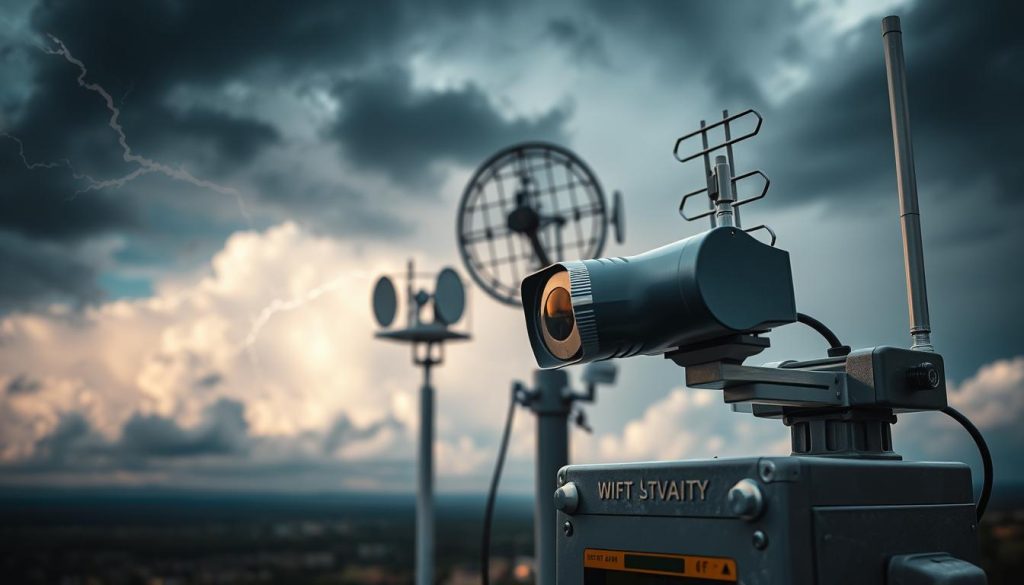
Air Quality Monitors
Air quality monitors are key for those worried about pollution and indoor air. They track pollutants that can harm your lungs. These devices are essential for health-conscious people.
PurpleAir Sensors
PurpleAir sensors have changed how we monitor air quality. They measure PM2.5 in real-time and share data on a public map. This network approach gives valuable insights and immediate air quality info to households.
IQAir AirVisual Pro
The IQAir AirVisual Pro is for those who need detailed air quality analysis. It tracks PM2.5, CO2, humidity, and temperature. Its display shows an air quality index score, making it easy to understand and act on.
UV and Solar Radiation Measurement Tools
UV monitoring devices help understand sun risks and solar energy. They’re useful for skin cancer prevention, solar panel use, and agriculture. These tools are crucial for health and efficiency.
Portable UV meters like the Solarmeter Model 6.5 give precise UV index readings. Advanced stations like the Davis Instruments UV Sensor track daily exposure. Some devices even send sun safety tips to your phone based on your skin and sunscreen.
| Device Type | Popular Models | Price Range | Key Benefits | Ideal Users |
|---|---|---|---|---|
| Lightning Detectors | Strike Alert, WeatherFlow Tempest | $80-$350 | Early storm warnings, strike distance estimation | Outdoor enthusiasts, sports facilities |
| Air Quality Monitors | PurpleAir, IQAir AirVisual Pro | $200-$500 | Real-time pollution data, health recommendations | Allergy sufferers, urban residents |
| UV Radiation Meters | Solarmeter 6.5, Davis UV Sensor | $150-$300 | Sun exposure management, solar efficiency | Outdoor workers, solar enthusiasts |
| Multi-Parameter | Kestrel 5500, Ambient Weather WM-4 | $300-$700 | Comprehensive environmental assessment | Researchers, environmental professionals |
Smart Weather Monitoring Devices for the Connected Home
Homes are getting smarter, and weather monitoring devices are key. They do more than show the temperature. They help your home make smart choices based on the weather.
Integration with Smart Home Ecosystems
Today’s weather stations work with smart home systems. They turn weather data into useful actions. This makes your home more comfortable, efficient, and safe.
Amazon Alexa and Google Home Compatibility
Voice assistants have changed how we use weather devices. You can ask for weather info without looking at a screen. Here are some examples:
- “Alexa, what’s the temperature in my backyard?”
- Hey Google, will my garden need watering today?”
- “Alexa, what’s the wind speed right now?”
- “Hey Google, what’s the humidity level in the basement?”
IFTTT and Home Automation Possibilities
Connected weather devices get really powerful with IFTTT. They can start actions on their own based on the weather.
For example, blinds can close when it gets too sunny. Or, you can get alerts to move patio furniture in windy weather. Some even adjust irrigation based on rain.
Mobile Apps and Remote Monitoring Capabilities
Most weather devices come with mobile apps. These apps let you see weather data in a way that matters to you. They also show historical data, helping you spot trends.
With remote access, you can check your home’s weather from anywhere. You can also set alerts for specific weather conditions.
Weather Data Sharing Networks
Sharing your weather data with networks like Weather Underground helps everyone. It improves forecasts and lets you compare your area’s weather with others.
But think about privacy when sharing your data. Most networks protect your location. Still, it’s good to check their privacy policies before joining.
Portable Weather Monitoring Tools for Outdoor Enthusiasts
Outdoor lovers often use small weather tools when they’re away from home. These tools help them understand wind, temperature, and more. This info is key for staying safe and comfy on adventures.
Handheld Anemometers
Handheld anemometers are top for checking wind speed outside. They give precise readings. This helps kayakers, sailors, and paragliders know when it’s safe to go out.
Kestrel 5500 Weather Meter
The Kestrel 5500 is a top-notch portable weather station. It measures wind speed, temperature, humidity, pressure, and altitude all in one. Hunters and long-range shooters love it for its ballistics calculator.
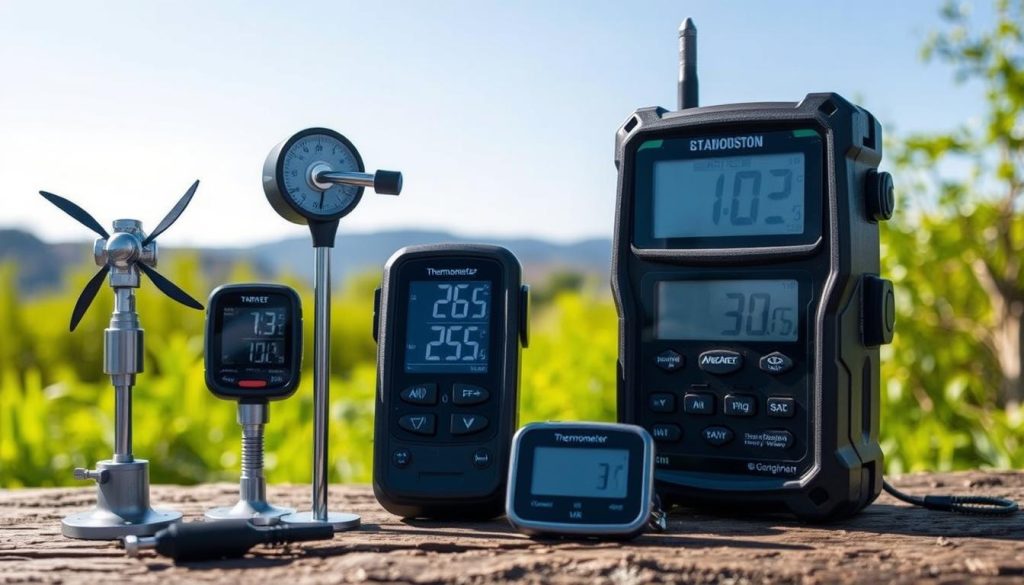
For a budget-friendly choice, the Weatherflow WEATHERmeter is great. It connects to phones via headphone jack or Bluetooth. It’s perfect for those who love weekend trips.
Pocket Weather Stations
Pocket weather stations are small and all-in-one. They’re great for hikers and campers. They might not be as precise as bigger stations, but they’re super handy.
These small units track temperature, humidity, pressure, and sometimes wind speed. They also forecast trends based on pressure changes. This helps users know when weather is about to change.
Smartphone-Connected Weather Tools
Smartphones can turn into weather stations with the right accessories. Attachable sensors and apps make phones into weather tools.
These tools range from simple wind meters to full weather sensor arrays. They connect via Bluetooth. The best part is they work with your phone’s power and display, and you can share data right away.
| Device Type | Price Range | Key Features | Best For |
|---|---|---|---|
| Handheld Anemometers | $50-$400 | Wind speed, direction, temperature | Sailors, paragliders, shooters |
| Pocket Weather Stations | $75-$200 | Multiple sensors, compact size | Hikers, campers, general outdoor use |
| Smartphone Attachments | $30-$150 | App integration, data sharing | Tech-savvy users, social sharing |
| Professional Units (Kestrel) | $200-$700 | High accuracy, specialized calculations | Professional guides, serious enthusiasts |
Agricultural Weather Stations: Optimizing Farm Operations
Environmental monitoring equipment has changed farming. Today, farmers must make smart decisions due to changing weather. Weather stations give them the data to improve crop production.
Soil Moisture and Temperature Monitoring
Soil conditions are key to growing crops. Modern systems track moisture and temperature at different depths. This helps farmers understand soil health.
Davis Instruments Soil Moisture Sensors
Davis Instruments has affordable soil monitoring tools. They work well with their weather stations. These sensors are great for small farms, allowing monitoring of up to four stations at once.
METER Group TEROS Soil Sensors
METER Group’s TEROS sensors are top-notch. They measure moisture, temperature, and more. This detailed data is perfect for research and growing valuable crops.
Frost Prediction and Crop Protection Systems
Frost can harm crops quickly. Weather stations predict frost with high accuracy. This early warning lets farmers protect their crops, saving harvests.
Irrigation Management Based on Weather Data
Water conservation is key for farms. Weather data helps farmers water crops just right. This saves water and boosts crop health.
Weather-based irrigation cuts water use by 20-40%. A California vineyard saved 500,000 gallons a year. It also improved grape quality and yield.
These systems are a big investment. But they save resources, protect crops, and increase yields. They’re crucial for farmers facing today’s challenges.
Future Trends and Making the Most of Your Weather Monitoring Investment
The world of weather monitoring devices is changing fast. Now, AI systems can make very accurate, local weather predictions. These predictions were not possible just a few years ago. Also, smaller, cheaper sensors are making it easier for everyone to track the weather, not just scientists and weather fans.
To get the most from your weather tools, keeping them in good shape is important. Clean your sensors every month, check the batteries every season, and update your equipment once a year. These steps can make your device last longer and keep your readings accurate.
The future of personal weather stations is exciting. Soon, they will work better with smart homes. Your heating, cooling, and irrigation systems will adjust automatically based on real-time weather data. We’ll also see smaller sensors that fit easily into your home.
By sharing your weather data, you help improve forecasts for everyone. This teamwork helps scientists understand climate changes and extreme weather better. Your data is a big help in their work.
Whether you have a simple rain gauge or a full weather station, it connects you to local weather. This connection is useful and helps you understand the natural world better. As weather becomes more unpredictable, these tools give you peace of mind and useful information for your daily life.

